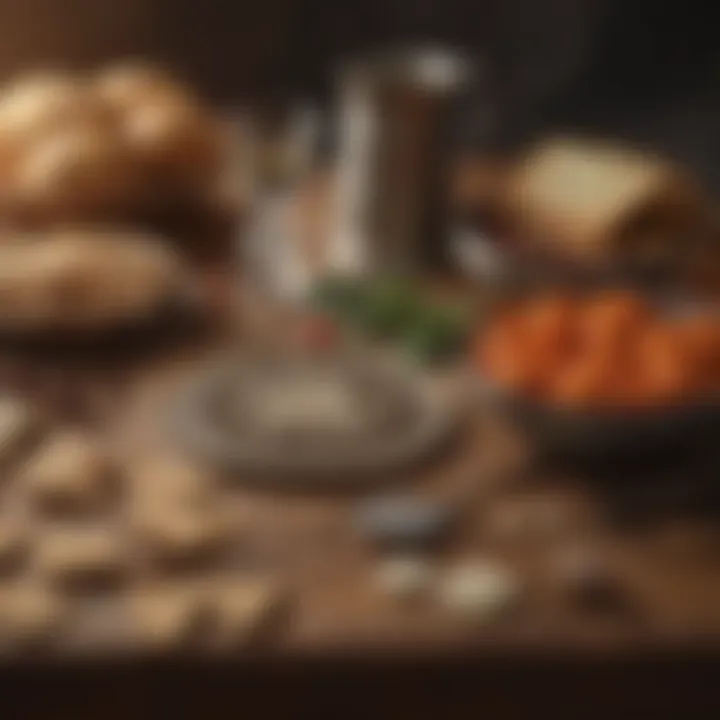Foods to Avoid During Passover: A Comprehensive Guide


Intro
Passover represents a time of reflection and remembrance for many individuals. During this holiday, certain foods are traditionally deemed prohibited, and understanding these restrictions is essential for observance. Not only does this knowledge impact religious practices, but it also shapes dietary choices and meal preparations for those participating in the festivities. This article aims to dissect the key food prohibitions and their historical significance, providing readers with insights into compliance and alternatives for a meaningful Passover experience.
In addition to discussing specific food items, we will explore how these restrictions affect modern customs and social gatherings during Passover. Grasping the context of these prohibitions enables individuals to embrace the holiday more fully.
“Tradition is not the worship of ashes, but the preservation of fire.”
We will delve into aspects related to food instead of linking them to a broader wellness perspective that might include fitness or mental health. This will keep our focus sharp on food choices, their preparation, and the guiding principles behind dietary regulations during Passover. By the end, readers will be better equipped to navigate their culinary choices throughout this sacred time.
Prolusion to Passover Dietary Restrictions
The topic of dietary restrictions during Passover is vital for understanding the observance of this significant holiday. These restrictions are rooted in religious tradition and history, and they provide a framework for personal and communal experience during this time. By exploring these restrictions, individuals can grasp the importance of their dietary choices, ensuring that they align with the customs and rituals associated with Passover.
The Significance of Passover
Passover, or Pesach in Hebrew, commemorates the liberation of the Israelites from slavery in Egypt. This festival emphasizes themes of freedom and redemption. Each year, Jewish families gather to retell the story of Exodus, engaging in rituals that bring the past into the present. Food plays a central role in these observances, serving not only as sustenance but also as a symbol of the historical events being remembered. The dietary practices during this period strengthen community bonds and connect participants to their heritage.
Historical Context of Food Restrictions
The restrictions on food during Passover have a deep historical basis. The key prohibition is the avoidance of chametz, which refers to leavened products made from certain grains. This practice has origins in the haste of the Israelites' escape from Egypt. As they fled, there was no time for bread to rise, leading to the tradition of eating matzah, or unleavened bread.
Over centuries, various interpretations have emerged about what foods are included in this prohibition. Today, the most commonly avoided items are products made from wheat, barley, rye, oats, and spelt that have fermented or leavened. Recognizing the roots of these restrictions helps individuals appreciate the historical significance behind what may seem like mere dietary choices today.
Overview of Forbidden Foods
Understanding which foods are forbidden during Passover is crucial for those observing the holiday. The regulations surrounding these foods, known as chametz, stem from historical and religious significance. This section delineates these prohibitions, helping readers navigate the complexities of Passover dietary guidelines.
Understanding Chametz
Chametz refers to food products made from specific grains that have leavened, or risen, as a result of fermentation. The consumption of chametz during Passover is prohibited in order to commemorate the Exodus of the Jewish people from Egypt. This historical event is associated with the hasty departure of the Israelites, who did not have the time to allow their bread to rise. Consequently, avoiding chametz is an act of remembrance and adherence to tradition.
By recognizing chametz, followers of Passover can enhance their understanding of the restrictions, connecting their dietary choices to their cultural and religious identity. This comprehension not only honors tradition but also reinforces community bonds among those observing Passover.
Types of Foods Considered Chametz
The following are the primary categories of foods deemed chametz, each carrying significance with respect to Passover practices.
Grains
Grains serve as the base for many familiar foods. During Passover, it is important to identify which grains contribute to chametz. Wheat, barley, rye, oats, and spelt are the primary offenders. These grains can produce flour that leads to leavening when combined with water and left to rise. Understanding this aspect helps in recognizing why avoiding grains ensures observance during the holiday.
The key characteristic of grains, particularly wheat, is their ability to ferments effectively. This feature, whilst beneficial for many baking purposes, makes them unsuitable during Passover. Additionally, the widespread use of these grains in various processed foods further complicates compliance.
Leavened Products
Leavened products encompass a broad range of food items that have incorporated air to achieve a light texture. Notably, bread, pasta, and baked goods fall within this category.
The essential characteristic of leavened products is their reliance on fermentation. This process increases volume and creates a softer texture. However, during Passover, consumption of these items must be avoided to adhere to traditions established for the holiday. Understanding the nature of leavening helps ensure observance of Passover restrictions, safeguarding cultural practices.


Leavened products bring a unique texture and flavor to many meals, which makes their absence during Passover more pronounced. However, many alternative unleavened options exist that can satisfy culinary cravings.
Beverages
Certain beverages may also contain chametz. This includes beer, malt beverages, and some vinegars. The fermentation process utilized in these drinks can render them unsuitable for consumption during Passover.
The defining feature of many alcoholic and non-alcoholic beverages is their use of grains to produce alcohol. Understanding these subtle connections helps individuals remain vigilant about their beverage choices throughout the holiday. Some beverages that drinkers enjoy may inadvertently contain wheat or barley, underscoring the importance of reading labels carefully.
Additionally, restrictions on beverages provide insight into how to approach meal pairings. Knowledge of what drinks can accompany meals is imperative for maintaining dietary traditions during Passover.
Grains: The Core Prohibition
In the context of Passover, grains hold a central significance due to their classification as chametz. Chametz refers to any food product that contains one of the five major grains that have fermented or risen. For those observing Passover, understanding which grains are forbidden is essential as it directly impacts meal preparation and dietary choices during this important holiday. The prohibition is rooted in both historical and religious teachings and serves to commemorate the hasty departure of the Israelites from Egypt.
The avoidance of chametz, particularly grains, helps reinforce the themes of freedom and remembrance that are intrinsic to Passover. Engaging with these dietary restrictions can be a way to deepen one's spiritual experience during the holiday. A mindful approach to food can lead to new culinary adventures, encouraging creativity around meal planning.
Wheat
Wheat is often the most recognized grain in the context of Passover. As a staple in many diets worldwide, its role during this holiday is especially noteworthy. Any food product made from wheat that has leavened is prohibited. This includes traditional breads and pastries that many people typically enjoy.
It is essential for individuals preparing for Passover to check ingredient labels closely for hidden wheat derivatives as they can appear in various processed foods. Some common wheat derivatives include:
- Semolina
- Durum flour
- Spelt
This makes it crucial for observant individuals to be diligent in their meal preparation to ensure compliance with these dietary restrictions. Eating matzah, an unleavened bread made specifically for Passover, serves as a key alternative for those requiring bread-like options.
Barley
Barley holds a similar position to wheat during Passover. It is often used in various forms, such as in soups or as malt in beverages. The presence of barley is a significant concern primarily because of its ability to ferment easily, thus producing chametz if not monitored carefully.
Barley can be hidden in foods like:
- Certain beers and malt beverages
- Barley grains in soups and stews
Therefore, keen attention is required. Reading labels is imperative when seeking to avoid barley during this festive time. Alternatives like rice or quinoa can be employed in recipes as substitutes to maintain a satisfying diet while adhering to Passover guidelines.
Rye and Oats
Rye and oats also fall under the prohibition of grains during Passover. Like wheat and barley, the fermentation of these grains leads to chametz formation, making them unsuitable for consumption throughout the holiday.
Rye is typically found in:
- Rye bread
- Crispbreads
Oats, while often considered healthier compared to other grains, can also pose problems in terms of compliance. They might be included in products such as:
- Granola bars
- Oatmeal
For those seeking healthier options, consider focusing on non-grain alternatives such as fruits and vegetables. This not only supports the Passover dietary restrictions but also provides nutritional benefits.
In summary, grains represent a crucial aspect of Passover dietary laws. Awareness of what constitutes chametz and the implications on one’s meal planning is vital for those observing this holiday. By exercising diligence in reading labels and exploring alternative ingredients, one can navigate these prohibitions while ensuring a meaningful and reflective Passover experience.


Leavening Agents to Avoid
During Passover, observing dietary restrictions is crucial, particularly when it comes to leavening agents. Leavening agents play a significant role in the texture and rise of baked goods. However, these agents can easily make food non-compliant for those honoring the Passover tradition. Understanding which leavening agents to avoid ensures that the food serves both tradition and adherence to dietary rules.
Yeast
Yeast is a microorganism that ferment sugars and produce carbon dioxide, causing the dough to rise. In many cultures, yeast is the go-to leavening agent for bread and baked goods. However, during Passover, the consumption of yeast is strictly prohibited due to its leavening properties. The active fermentation can lead to the production of chametz, which is any food that has risen and contains prohibited ingredients.
For those preparing for Passover, it is essential to observe a total prohibition on yeast. Any products containing yeast, including bread, rolls, and certain baked pastries, must be avoided.
Baking Powder
Baking powder is another common leavening agent, often used to give baked goods a light and airy texture. It typically contains a combination of acid and alkaline components that react when moistened, creating carbon dioxide bubbles that cause rising. Despite its convenience, baking powder must also be avoided during Passover. It can contain starch derived from grains that are prohibited during this holiday.
While shopping for baking supplies before Passover, check ingredient labels carefully. Some baking powders may contain cream of tartar, which is acceptable, provided it does not combine with chametz components.
As a general guideline, if you are not entirely sure about a product's ingredients, it is better to err on the side of caution.
It is essential to focus on using alternative leavening methods that align with Passover restrictions.
In summary, the avoidance of leavening agents like yeast and baking powder is a fundamental aspect of maintaining the integrity of Passover dietary laws. By understanding their roles and alternatives, individuals can ensure that their meal preparations uphold tradition while exploring new, compliant recipes.
Beverages That May Contain Chametz
Understanding the potential for beverages to include chametz is crucial during Passover observance. While it is common to focus on solid foods when considering chametz, many people overlook drinks that might contain forbidden ingredients. Being informed about these options can help ensure a faithful adherence to dietary restrictions while still allowing for enjoyable beverages throughout the holiday.
Alcoholic Beverages
Alcoholic beverages present a significant concern during Passover for those observing the dietary laws. Beers and ales generally contain grains that are chametz, as they are often brewed using barley or wheat. The fermentation process of these grains results in a product that cannot be consumed during the holiday.
Wine is often a focal point during Passover celebrations, but it is essential to ensure that it is kosher for Passover. Many wines may contain additives that are not compliant. Thus, seeking out specifically labeled kosher for Passover wines is an important consideration. Always check the label for certification to avoid inadvertently consuming chametz.
Soft Drinks
Soft drinks also warrant careful examination. While it might seem less likely that a soda would contain chametz, some brands and varieties may use flavorings or additives derived from chametz sources. Ingredients like malt syrup, used in certain colas, are directly derived from barley, therefore making them forbidden.
Aside from looking for potential chametz ingredients, the context of how soft drinks are manufactured can also affect their status. Cross-contamination during production processes can lead to products being unsuitable for Passover. Opting for brands that explicitly mark their beverages as kosher for Passover can substantially reduce the risk of consuming chametz during the holiday. Always consult product labels and stick to trusted brands.
"Being conscious about beverages can enhance the Passover experience and support steadfast adherence to tradition."
Additional Food Categories to Consider
When preparing for Passover, it is essential to understand not only the main forbidden foods but also other food categories that may be problematic. This section delves into processed foods and dairy products, highlighting why they deserve special attention during this holiday. Knowing what to avoid can help individuals adhere to the dietary restrictions while still enjoying flavorful meals.
Processed Foods
Processed foods encompass a wide range of items, from snacks to sauces, which may contain hidden chametz ingredients.
Packaged Snacks


Packaged snacks are often convenient and widely enjoyed. However, their ingredients can vary greatly. Many commercial snacks contain additives or starches that originate from grains like wheat or barley, making them unsuitable for Passover. Consumers should carefully read labels to identify any prohibited substances. Additionally, these snacks are typically processed, which raises questions about their purity and compliance with Passover standards. The key characteristic of these snacks is their convenience. While they can be an easy choice, the potential for chametz inclusion necessitates caution. Therefore, it is wise to opt for snacks labeled as "Kosher for Passover."
Condiments
Condiments can play a crucial role in enhancing flavors. However, many may contain hidden chametz ingredients. Common condiments such as barbecue sauce, soy sauce, or even some salad dressings often use ingredients derived from grains. This can be surprising to those unfamiliar with the various components of food products. The uniqueness of condiments lies in their ability to transform dishes. Thus, it is vital to seek out those specifically marked as compliant with Passover guidelines to avoid infringing dietary rules. Overall, both processed snacks and condiments require vigilant scrutiny to ensure a meaningful observance of Passover.
Dairy Products
Dairy products also warrant consideration during Passover. While they are not inherently forbidden, some dairy items may contain additional ingredients that are not kosher for this holiday. For example, certain cheeses or creams may incorporate stabilizers or flavorings derived from grains. It is essential to look for products specifically labeled as "Kosher for Passover" to ensure compliance. Furthermore, exploring alternative options, like almond milk or coconut yogurt, can provide variety without violating dietary laws. Awareness of the potential pitfalls within these categories will aid in making informed decisions while planning meals around Passover.
Preparing for Passover: Meal Planning
Meal planning for Passover is essential for those who want to adhere to the dietary restrictions that come with this significant period. This practice helps in creating menus that are compliant while ensuring satisfaction for all who gather to celebrate. Thoughtful planning also reduces stress as the holiday approaches, allowing for a more enjoyable and meaningful experience with family and friends.
Effective meal planning during Passover requires a careful consideration of ingredients and recipes. Understanding which foods are permissible, such as matzah and certain vegetables, is key to creating meals that honor tradition while also satisfying diverse palates. Without proper planning, one might inadvertently include chametz, the leavened products that are strictly prohibited during this time. Therefore, the importance of preparation cannot be overstated.
Identifying Compliant Ingredients
When identifying compliant ingredients for Passover, focus on items that align with the kosher guidelines for the holiday. Some essential ingredients include:
- Fruits and vegetables: Fresh produce is largely permissible. It is important to wash them thoroughly and ensure no contamination with chametz.
- Meat and fish: Ensure that these products are certified kosher for Passover, as some processing methods may introduce non-compliant substances.
- Matzah: This is a key staple during Passover and should be used in various recipes. Look for products specifically labeled for Passover use.
- Eggs: They are an excellent source of protein and are generally accepted, provided they are kosher.
To simplify compliance, it is advisable to read labels carefully and, when in doubt, to consult with a knowledgeable authority on kosher foods during Passover.
Alternative Recipes
Finding alternative recipes that fit within the restrictions of Passover can greatly enhance the meal experience. Here are some ideas:
- Cauliflower Matza Pizza: A creative twist on traditional pizza, using a cauliflower crust instead of regular dough.
- Zucchini Noodles with Pesto: A fresh and light alternative to pasta dishes, satisfying the craving without using grains.
- Stuffed Bell Peppers: These can be filled with quinoa (if certified kosher for Passover) or a variety of vegetables and spices, offering a colorful and nutritious option.
- Chocolate Coconut Macaroons: A delightful dessert made with compliant ingredients, ensuring a sweet finish to the meal.
Additionally, by utilizing online resources like Wikipedia, Britannica, and forums on Reddit to explore more ideas and join discussions around Passover cooking, one can ensure their offerings are diverse and enjoyable.
"Preparation is the key to making Passover a rewarding and stress-free experience."
End: Navigating Dietary Restrictions with Confidence
Navigating dietary restrictions during Passover is not merely an exercise in compliance; it is an opportunity to engage with one’s culture and faith deeply. Understanding what foods to avoid and the rationale behind these restrictions equips individuals to participate more fully in the traditions of the holiday. Therefore, it is essential to approach Passover meal planning intentionally.
The significance of being informed cannot be overstated. Knowledge about chametz, the types of foods that are forbidden, and suitable alternatives can transform the experience. Observing these dietary rules may feel restrictive, but with creativity and planning, one can create delicious meals that honor tradition while meeting dietary needs.
Additionally, this mindful approach to meal preparation has broader benefits. It often promotes healthier eating habits and encourages fresh, whole foods, steering one away from processed options that may not align with Passover guidelines. Engaging with the food one prepares can enhance the family experience, making the observance of Passover richer and more meaningful.
As you embark on your Passover journey, remember that every meal is an opportunity to celebrate, educate, and involve your loved ones in traditions that matter.
Embracing Tradition and Health
Embracing the traditions of Passover while maintaining health standards is crucial. This balance is achievable through informed choices. Recognizing the significance of foods avoided during Passover fosters respect for customs while also allowing for personal health considerations.
Many traditional Passover foods, such as matzo, can be incorporated into creative recipes that satisfy both dietary restrictions and taste preferences. By focusing on fresh vegetables, fruits, and compliant proteins, one can enjoy nutritious and delightful meals without violating the observance of chametz. This not only respects the tradition but also enriches the family's dietary patterns, promoting healthier eating habits year-round.
Resources for Further Information
Several resources can help individuals navigate the specifics of Passover dietary restrictions:
- Wikipedia: A general overview of Passover, including its history and food restrictions. Visit en.wikipedia.org for more details.
- Britannica: Offers in-depth articles on the cultural significance and practices of Passover at britannica.com.
- Reddit: Join conversations with others observing Passover, sharing tips and recipes. Explore these discussions at reddit.com.
- Facebook Groups: Find community support and ideas through dedicated groups for Passover observance on facebook.com.
Utilizing these resources can enhance understanding and provide additional encouragement for those observing dietary restrictions during Passover.



